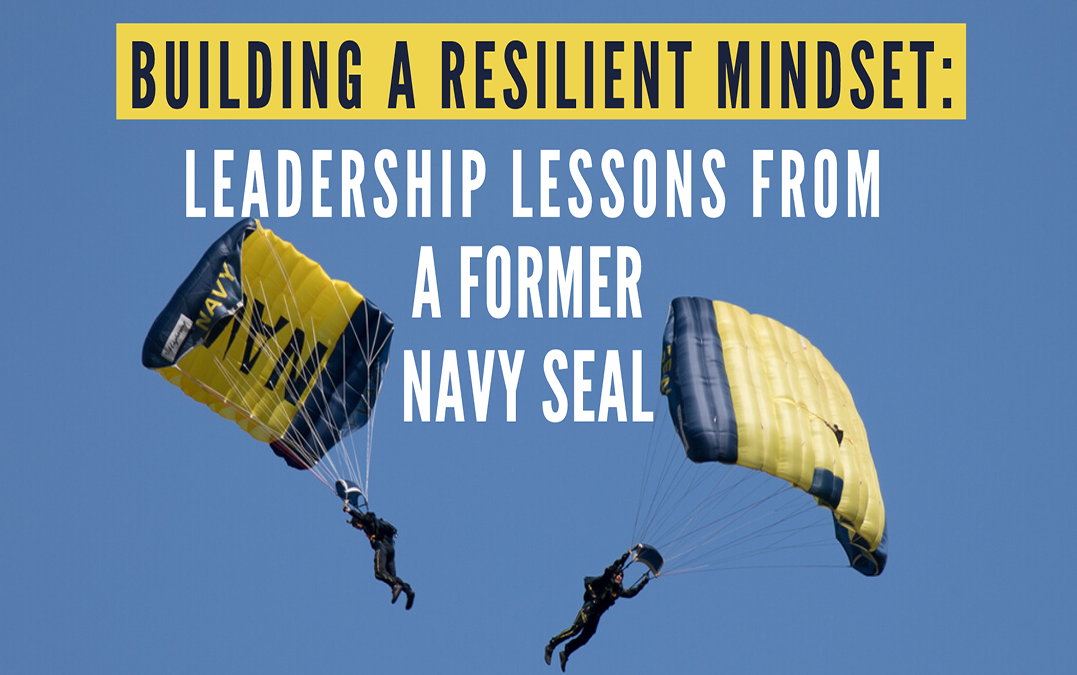
Leadership
As the country heads toward reopening, we won’t just be able to toggle back to business as usual. Every employee will be returning to work with varying levels of anxiety. Some may have lost a person close to them. Some may feel fatigued from living through weeks of uncertainty. Others may have survivor’s guilt if some of their co-workers were recently laid off or furloughed.
I discussed this topic last Thursday when I interviewed Retired Navy SEAL Officer Lance Cummings on building a resilient mindset (watch the recording here). Using concepts and techniques gained from his 30-year military career, Cummings shared what kind of mindset is necessary for leaders to help their teams deal with the trauma of COVID-19 and as they return to work.
Below is a sampling of the leadership concepts from our interview that leaders can apply today as we prepare for businesses reopening:
Make space for decompression
When returning from a war zone, operators need a transition period to adjust to the new reality. We transition back carefully, with at least one stop along the way to decompress and discuss how to adjust smoothly and smartly. We solicit help from medical and psychological professionals. This facilitates the transition and emotional trauma, especially if you’re returning with fewer than you deployed with.
Good leaders help prepare for both the deployment and return by showing compassion for those who need a little more help with transition.
Acknowledge and deal with trauma
Acknowledge that there will be trauma within the ranks, and it will be expressed or compartmentalized in different ways. The emotional aspect of losing a loved one, or living in fear of losing someone, is tremendous. It should be verbalized that assistance is available and that there will be no stigma about taking advantage of emotional counseling.
Situational awareness is a perishable skill, but if you can watch others from an objective position, body language and work habits will telegraph masked stress.
Provide clear guidance and lead by example
There may have been downsizing within the company. That can’t be ignored. People have a right to know where they stand in the hierarchy and why. An employee’s perception can be different from their boss’, but this gap can be minimized with open communication. Sometimes we can be too ambiguous, and the message isn’t clear.
Leadership by example cannot be overstated. If the Commanding Officer of the team is attending daily COVID-19 screenings, the troops are less likely to complain about it.
As many of us pivoted from in-person to online meetings during this quarantine, we can leverage the gifts of stripping away the office hierarchies that create distance among people. From watching kids run amuck in the background, to hearing dogs bark, to noticing your colleague is a U2 fan by virtue of the Bono posters hanging on their walls, we can lean into the fact that we know each other even better as human beings. We’ve created new bonds of trust. Let’s carry this trust forward and emerge as a more resilient team.
How are you helping your team pivot while dealing with the trauma of what they’ve just gone through?
Driven by the premise that excellence is the result of aligning people, purpose and performance, Center for Executive Excellence facilitates training in leading self, leading teams and leading organizations. To learn more, subscribe to receive CEE News!

Leadership
During the 3 minutes it will take you to read this post, you’ll probably get an email with COVID-19 in the subject line, a text, a social media update or a missed call. Let 30 minutes pass, and you could be swimming in unanswered inbounds. A steady diet of requests for your attention can leave you overwhelmed and intellectually and emotionally undernourished.
You cannot lead effectively when your plate is full, but your cup is empty.
As a leader, you have a responsibility to create a culture of performance. Research shows that your ability to do so will require you to carve out your most precious resource – time – for yourself to reflect. In his March 2013 Harvard Business Review article, JP Morgan Managing Director Chris Lowney suggested that leaders need to take a mental pit stop. As a former Jesuit seminarian, Lowney recalled that St. Ignatias of Loyola, founder of the Jesuits, recommended a practice known as “examen.” Simply put, it’s the concept of examining your day and taking stock.
Before you move onto your next thing to do, make a commitment to yourself to refuel by practicing the 3 G’s for daily reflection. Find a notebook and select a time and place each day to “examen,” as follows:
Practice Gratitude. A 2013 survey of 2,000 Americans by the John Templeton Foundation found that people are less likely to feel gratitude about work than anyplace else. In fact, respondents tended to rank their jobs as dead last when asked to list the things they were grateful for. Yet, studies have shown that people who make a habit of recording what they are grateful for have more positive emotions, feel better physically and mentally, and feel more connected to others as a result. What or who at work are you grateful for?
Give Your Reserve. When your tank is low, the last thing you may think about is, “what can I do to help someone else?” But, research confirms that the warm glow you feel after giving someone else a boost can be mapped to neural hedonic activity (aka stimulate pleasure systems in the brain). So, pay for the coffee of the next person in the drive-thru. Call someone who needs it. Take the neighbor’s garbage cans in. It will give them something to be grateful for, and give yourself a lift as well. What little thing could you give today?
Extend Grace. There’s a saying that not forgiving someone is like drinking poison and hoping the other person dies. Remember when your colleague cut you off in mid-sentence on Zoom today when you were trying to make that point about the new project? Drop it. Whether she did it to undermine you or because she was caught up in the brainstorm, it’s over. She’s not burning up thinking about it. While you’re at it, give yourself some grace too. If you’re still punishing yourself for a mistake you made with the best of intentions, let it go. Who can you stop keeping score on?
Especially during these unpredictable days, you’re taking in more information than you ever have before. Make time for yourself to turn that information into knowledge, and that knowledge into insight.
Question: What do you do when your plate is full but your cup is empty?
Driven by the premise that excellence is the result of aligning people, purpose and performance, Center for Executive Excellence facilitates training in leading self, leading teams and leading organizations. To learn more, subscribe to receive CEE News!

People
Commencement ceremonies for the graduating class of 2020 will look markedly different this year. Parents won’t strain to pick out their daughter or son from a sea of identical cap-and-gown-clad graduates. The solemn program on stage won’t be interrupted by the sudden appearance of a bouncing beach ball. There’ll be no Silly String wars, random air horn blasts, or cap tossing after the diplomas have been handed out.
This graduation season will be anything but ordinary. But, that’s all the more reason why the Class of 2020 deserves extraordinary advice, heartfelt encouragement, and hard-won wisdom about facing new challenges in an uncertain world. Ryan Reynolds kicked things off on May 1st with a funny and sweet commencement speech for his alma mater, Kitsilano Secondary School in Vancouver, British Columbia. The video ended with a crawl saying that Reynolds missed local fave Nat’s Pizza, and every graduate would get a large pizza on him.
Here is a lineup of some of the other virtual events planned to lift up those celebrating graduation milestones this year.
A one-hour livestreamed event on Saturday, May 16th, at 8 p.m. Eastern, will feature President Obama with Lebron James, Pharrell Williams, the Jonas Brothers and Megan Rapinoe. Called Graduate Together, the program will celebrate high schoolers who have earned their diplomas. ABC, CBS, NBC and Fox will all broadcast it live.
Earlier that day, at 2 p.m. Eastern, President Obama will appear in a two-hour virtual commencement honoring graduates from 74 historically black colleges, called “Show Me Your Walk, HBCU Edition.”
Oprah is also making an appearance. On May 15th at 2 p.m. Eastern, Facebook is hosting a #Graduation 2020 for both high school and college grads. Oprah will appear with Lil Nas X, Jennifer Garner, Miley Cyrus, Simone Biles and Awkwafina.
For podcast fans, there is iHeart Media’s May 16th launch of “Commencement: Speeches for the Class of 2020,” featuring inspiring words from a long list of celebrities, sports stars, entertainers and business titans including Hillary Clinton, Eli Manning and John Legend.
On June 6th at 3 p.m. Eastern, the First Couple will appear on a YouTube virtual commencement, Dear Class of 2020. Lady Gaga, Alicia Keys, Malala Yousafzai and Alphabet CEO Sundar Pichai are among the guests.
Until then, both grads and non-grads can draw inspiration from the tongue in cheek advice of Trevor Noah and friends, like, “You are much stronger than you think. Just like that off brand toilet paper you found on the dark web.”
Question: What words of advice would you give the graduating Class of 2020?
Driven by the premise that excellence is the result of aligning people, purpose and performance, Center for Executive Excellence facilitates training in leading self, leading teams and leading organizations. To learn more, subscribe to receive CEE News!

Leadership
One of the most challenging things about life these days is the ability to choose how we spend our time. Suddenly, the routines that we relied on to navigate our days have been stripped away. We’ve been thrown off the well-rutted trails that helped dictate when to rise, what to wear, how to contribute, and what to do when we need a break. Then the wheels came off the frame. And each day, we choose anew.
Whether we’re on the front lines, or doing our part by staying at home, we’re all trying to navigate the path between anxiety and appreciation as we do what we can to be productive members of the human race. It is against this backdrop that I have been reading Leadership in Turbulent Times, by Doris Kearns Goodwin.
 The book parallels the lives of four U.S. Presidents – Abraham Lincoln, Theodore Roosevelt, Franklin Roosevelt, and Lyndon Johnson. Goodwin explores their early development and circumstances each man endured that shaped his leadership style. She refers to those circumstances as crucibles. Lincoln, for example, fell into a depression at the age of 32 that was so profound, his friends confiscated all knives, razors, and scissors from his room in fear that he may take his own life.
The book parallels the lives of four U.S. Presidents – Abraham Lincoln, Theodore Roosevelt, Franklin Roosevelt, and Lyndon Johnson. Goodwin explores their early development and circumstances each man endured that shaped his leadership style. She refers to those circumstances as crucibles. Lincoln, for example, fell into a depression at the age of 32 that was so profound, his friends confiscated all knives, razors, and scissors from his room in fear that he may take his own life.
As a brash, young Illinois state legislator, Lincoln had convinced the state to invest in massive infrastructure projects like railroads, canals, bridges and roads. These projects were barely half completed when, in 1840, Illinois entered the third year of a recession and halted the work. Land values plummeted, thousands lost their homes, banks and brokerage houses closed. Blame for the crushing debt that crippled the state was laid at Lincoln’s feet.
The burdens that Lincoln had sought to lift from the poorest and most thinly populated communities had been multiplied. The breach of honor he suffered as a result was almost too much for him to bear. “The doctors in Springfield believed that Lincoln was ‘within an inch of being a perfect lunatic for life,’” writes Goodwin. Lincoln confessed to his close friend, Joshua Speed, that he was more than willing to die, but that he had done nothing to contribute to the growth of the country.
The Declaration of Independence had been penned just 64 years earlier. Self-government was still considered a shaky experiment, at best, and Lincoln felt that the world’s monarchies were lying in wait for the experiment to fail. Lincoln gathered himself and set about to reconstruct his personal and public life. Not only did he endure, but he went on to lead the country brilliantly through the Civil War, one of the most significant trials in the history of our country.
We have the privilege of living during a collective crucible. Some people will lose their bearings; their lives forever stunted. Others will resume their normal behaviors after a period of time. Still others, through reflection and adaptive capacity, will transcend their ordeal, armed with a greater resolve a purpose. How you will be changed as a result of this crucible depends largely on how you choose to spend your time today.
What leadership book have you turned to for inspiration this month?
Driven by the premise that excellence is the result of aligning people, purpose and performance, Center for Executive Excellence facilitates training in leading self, leading teams and leading organizations. To learn more, subscribe to receive CEE News!

Letter from the Founder

Welcome to the fifty-seventh issue of CEE News!
One of the most challenging things about life these days is the ability to choose how we spend our time. Suddenly, the routines that we relied on to navigate our days have been stripped away. We’ve been thrown off the well-rutted trails that helped dictate when to rise, what to wear, how to contribute, and what to do when we need a break. Then the wheels came off the frame. And each day, we choose anew.
Whether we’re on the front lines, or doing our part by staying at home, we’re all trying to navigate the path between anxiety and appreciation as we do what we can to be productive members of the human race. It is against this backdrop that I have been reading Leadership in Turbulent Times, by Doris Kearns Goodwin.
(more…)






